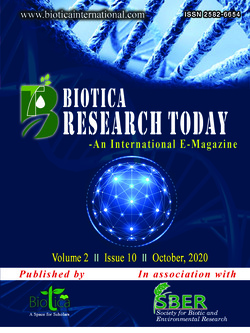
Brucellosis: An Infectious Outbreak in China and New Threat to Civilization after COVID-19
Gyanisha Nayak*
Dept. of Plant Breeding & Genetics, College of Agriculture, OUAT, Surya Nagar, Bhubaneswar, Odisha (751 003), India
Chetan Panda
Dept. of Agricultural Biotechnology, College of Agriculture, OUAT, Surya Nagar, Bhubaneswar, Odisha (751 003), India
Kailash Chandra Samal
Dept. of Agricultural Biotechnology, College of Agriculture, OUAT, Surya Nagar, Bhubaneswar, Odisha (751 003), India
DOI: NIL
Keywords: Brucella, Brucellosis, Climate change, Zoonosis
Abstract
Brucellosis, otherwise called “Undulant fever”, “Mediterranean fever” or “Malta fever” is a disease caused by a group of bacteria from the genus Brucella. These bacteria can infect both humans and animals and spreads in humans when people eat contaminated food, raw meat and unpasteurized milk. It affects people of all ages and both sexes. The bacteria can also be spread through the air or in contact with an open wound. The incubation period of the disease is usually 2–4 weeks. The disease causes flu-like symptoms, including fever, headaches, muscle pain, weakness, malaise and weight loss. Some symptoms can become chronic with subsiding over time. Treatment options include doxycycline 100 mg twice a day for 45 days, plus streptomycin 1 g daily for 15 days. The prevention of human infection is primarily based on raising awareness, food-safety measures, occupational hygiene and laboratory safety.
Downloads
not found
Reference
Casabuono, A.C., Czibener, C., Del Giudice, M.G., Valguarnera, E., Ugalde, J.E., Couto, A.S., 2017. New Features in the Lipid A Structure of Brucella suis and Brucella abortus Lipopolysaccharide. Journal of the American Society for Mass Spectrometry 28(12), 2716-2723.
Alfonso, J., Rodríguez-Morales., 2013. Climate Change, Climate Variability and Brucellosis, Recent Patents on Anti-Infective Drug Discovery 8, 4-12.
O’Callaghan, D., 2020. Human brucellosis: recent advances and future challenges, Infectious Diseases of Poverty 9, 101.
